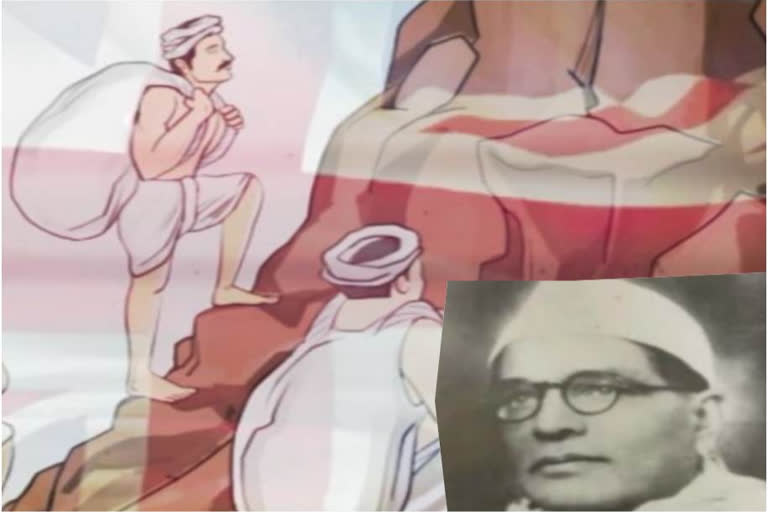Almora (Uttarakhand): Badri Dutt Pandey, born on Feb. 15, 1882 in Kankhal, Haridwar has the reputation of being praised by Mahatma Gandhi himself for his remarkable protest of Coolie-Begar movement in Uttarakhand.
Badri Dutt Pandey's family was originally from Patiya, Almora. After the death of his parents, Badri Dutt came to Almora. After his schooling, he went to Allahabad for higher studies. However, he had to drop out of his studies due to the untimely demise of his uncle who was supporting him financially.
With his school education, he got a government job and he happened to see the discrimination of Indians at the hands of British people. Frustrated, he decided to quit his job and join the freedom movement. He took up journalism as his career.
Initially, he worked with Leader Press and later joined Cosmopolitan published from Dehradun. In 1913, Badri Dutt Pandey became the sub-editor of the Almora newspaper. His journalistic skills benefitted the newspaper a great deal. The popularity of the newspaper started increasing with the articles of Badri Dutt Pandey. Within three months of his joining, the newspaper circulation increased from 60 to 1,500.
His sarcastic articles on British officials caused quite a stir those days. One day, the Deputy Commissioner fired at a porter who brought the soda late for his liquor. The porter suffered injuries on which Pandey wrote an article. The official clarified that the porter was caught in the crossfire as he was firing at the fowls. But it was not hunting season and Pandey published another article on how the law keeper could break the law on hunting in the off-season.
Unable to stand this row, the British administration got the newspaper closed. Pandey wrote in another newspaper thus, three victims on one shot - porter, fowl and the newspaper.
On the day of Vijay Dashami in 1918, Badri Dutt Pandey started a new newspaper Shakti. He was the editor of Shakti from 1913 to 1926. During this period, he wrote many articles, sharpening his criticism of the British. This increased the popularity of Shakti. He took the corrupt officials head-on.
In an article published in 1921, he wrote Rai Bahadur's crops increase every year while the wheat and paddy crops of farmers wither without water. Such kind of articles unsettled the bureaucrats. In 1926, Badri Dutt Pandey was elected as a member of the council. Though he left the newspaper after that, it is still published from Almora for more than 100 years.
Read: 75 Years of Independence: A poet family sowed seeds of revolution in Rajasthan
Among his many works, Badri Dutt Pandey is known for his success in eradicating the notorious Coolie-Begar practice in the hills. It was a practice of exploiting people in Uttarakhand for years. Under this, the British officers used to get the people here to work as porters for free without paying remuneration.
Badri Dutt Pandey started a movement against this in Kumaon. In the first session of the Kumaon Council in 1918, a resolution was passed against the Coolie-Begar system. On Jan. 10, 1921, Badri Dutt Pandey along with 50 agitators including Hargobind Pant, Chiranjeevi Lal went to the Bageshwar fair to gather support against this evil practice.
After reaching Bageshwar, a banner was made - with the slogan 'Stop the Coolie Begar', and it was rotated in the tents of the people staying in the fair and it turned into a mass movement. On the night of Jan. 12, 1921, 50 thousand people gathered in support of this movement. The deputy commissioner was there at that time. He was accompanied by 50 policemen and he wanted to fire at the crowd. He did not do in front of such a large crowd.
Badri Dutt Pandey was summoned by the Deputy Commissioner who threatened him with dire consequences. But he did not budge. The porters used to be registered in a register maintained by the village heads. A crowd of thousands, taking an oath not to yield to the Coolie-Begar system, dumped the registers related to Coolie-Begar in the river Saryu.
People honoured Badri Dutt Pandey with two gold medals and he gave them away for the Defence Fund in the 1962 China War. He was given the title of Kumaon Kesari for ending Coolie-Begar system. Mahatma Gandhi termed it as a bloodless revolution. He wrote about this revolution in his Young India too.
Apart from this, Badri Dutt Pandey ended the Nayak malpractice by campaigning between 1938-1945. Under the Nayak system, the people of the Nayak caste did not have any right over the land. They used to eke out a living by forcing their women into prostitution. Badri Dutt Pandey also ended this evil practice as well.
When Gandhiji came to Almora in 1929, he became the mouthpiece of Gandhiji during the meeting. As he addressed the meeting, Gandhi said that he was tired and couldn't speak loudly appealing to people to listen to him calmly. Badri Dutt Pandey told Gandhi to convey his message in a soft voice and in turn amplified Gandhi's message it to the crowd, which was upset that they could not hear the Mahatma.
Badri Dutt Pandey played an important role in the freedom struggle. But he had to pay a price for it as he was jailed four times for his works. He was in jail from December 1921 to November 1922, from June 1929 to March 1931, from January 1932 to August 1932 and from January 1942 to August 9, 1943.
While he was in jail in 1932, his son Tarak Nath and daughter Jayanti died. During this time he wrote the history of Kumaon in jail, which is still considered the most referred book of Uttarakhand. This great freedom fighter died on Feb. 13, 1965.
Read: 75 Years of Independence: Youth who traded his life for precious time in saving Kashmir



